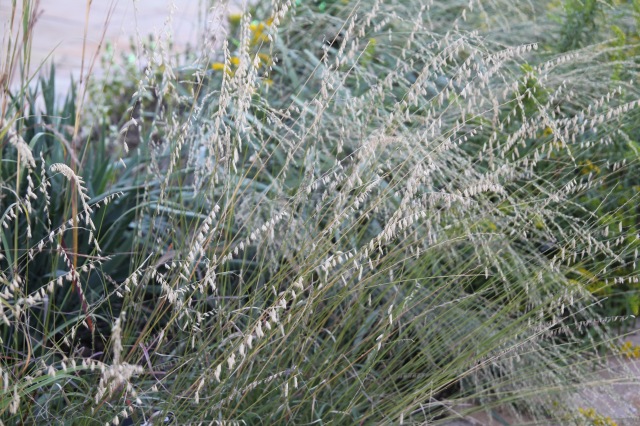
Planted Highway Median
With all this wintery weather are you thinking about those poor plants sitting under salty piles of snow? Or are you feeling sorry for the leaves on median plantings that are being sprayed by a salty brine as brave commuters speed past on their way to their destination.
As more municipalities are looking to green their infrastructure and trying to plant plants in as many places as possible to capture storm water, slow run off, reduce emissions and capture carbon green spaces are popping up in small places especially among paved areas.
Hellstrip is a term attributed to Laura Springer Ogden to describe the strip of open space (?) between the sidewalk and the street. The term has expanded to include roadway medians, parking lot islands and any green space tucked into a primarily paved area.
There are many reasons in addition to the obvious environmental reasons to include plantings in these impermeable places, but the challenges of keeping anything alive in these inhospitable conditions seem to make achieving these benefits impossible.
According to William Flemmer III, though these are human-made planting areas, they are very similar to the ecological conditions you may find in areas of primary succession. According to Flemer:
“when cleared land is abandoned in naturally forested areas, a gradual process of forest regeneration begins. The first trees are ‘pioneer’ species that can stand exposure to full sun and drying winds…. The ecological conditions of island plantings on highways are extremely harsh for tree growth and only pioneer species or species from dry, inhospitable climates can be expected to grow well.”
Sometimes looking at the roadways and seeing where Mother Nature has decided on her own where plants should grow can be a clue:

Solidago species grow on their own in a highway median.
As you are developing your planting lists for your green medians, parking islands and sidewalk strips consider the following plants. They are pioneer species (where the species help create soil) or secondary succession (where soil is present) species tolerant of drought and full sun. You can look to nature to see what is working. Rock outcroppings and sand dunes are actually great places to examine for successful plant communities in harsh conditions. Of course plant selection will depend on soil conditions, sun exposure and municipal regulations regarding height and spread. But the list below is a great place to start!

Monarda fistulosa
Solidago rugosa – Rough Goldenrod
Solidago canadensis – Canada Goldenrod
Euthamia graminifolia – Grass-leaved Goldenrod
Monarda fistulosa – Wild Bergamont
Of course full sun and dry limited soil mass are not the only challenges hellstrip plants face. Up in this region of the mid-atlantic and northeast US salt is also of concern. The following plants have been listed in various sources as suitable for use in medians and parking lot islands with dry soils and in full sun and the potential of salt exposure.
Agastache foeniculum – Anise Hyssop
Andropogon gerardii – Big Bluestem
Andropogon virginicus – Broomsedge
Asclepias tuberosa – Butterfly Milkweed

Bouteloua curtipendula
Bouteloua curtipendula – Sideoats grama
Deschampsia flexuosa – Crinkled hairgrass
Echinacea purpurea – Purple Coneflower

Liatris aspera
Liatris aspera – Rough Blazing Star
Panicum virgatum -Switchgrass and its cultivars

Pycnanthemum flexuosum
Pycnanthemum flexuosum – Appalachian Mountain Mint
Rudbeckia hirta – Sweet Black-eyed Susan
Schizachyrium scoparium – Little Bluestem and its cultivars
Sorghastrum nutans – Indian Grass
Sporobolus heterolepsis – Prairie Dropseed
For ideas of other plants (including many tree and shrub options) to use in these challenging conditions check out these resources:
Green Sustainable Parking Lot Guidebook
Pennsylvania Department of Transportation Roadside Planting Guidebook

Hellstrip Gardening by Evelyn J Hadden – primary focus is on herbaceous plantings in residential sidewalk areas – perhaps not applicable to the tougher conditions of highways and partkinglots, but good to review for ideas and plant selection ideas.
The plants in this post are considered suitable for hot, dry, sunny conditions. If you are looking for plants to plant in bioretention basins and other green infrastructure features, check out our previous post on Slowing Storm Water with the right plants.
What plants have you found work best in hellstrips?


[…] Aster […]
[…] Agastache foeniculum – Anise Hyssop […]
[…] Bluestem Little Bluestem A fall display of Seersucker Sedge Bouteloua […]